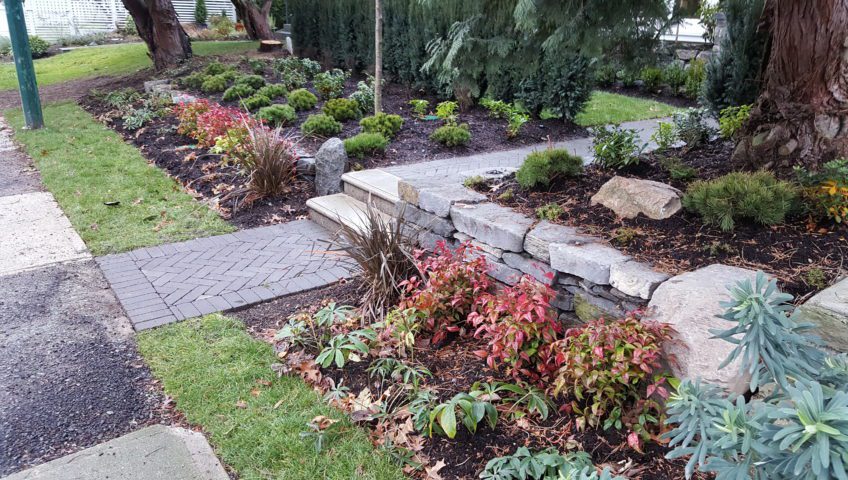Having a beautifully landscaped yard is not just about impressing your neighbors and enhancing your home’s curb appeal. It’s also about the way your house looks with well-planned greenery, such as detailed landscaping around shrubs and flower beds. Gardening becomes a personal journey that breathes life, brims over with colors, and offers you a tranquil retreat, right in the comfort of your own home.
No matter your experience level, embarking on the landscaping journey may seem daunting. But don’t stress! From picking the right plants to utilizing the space smartly, this guide to landscaping for beginners is here to empower you. With our easy-to-follow tips and creative landscaping ideas, you are one step away from transforming your yard into an enviable oasis. So let’s roll up our sleeves, embrace the dirt, and begin this exciting journey towards a beautiful yard!
Our comprehensive guide on landscaping for beginners covers everything you need to know to transform your yard. It includes a detailed list of gardening techniques and elements, from essential design principles and practical tips on plant placement based on height, spacing, and overall design to step-by-step instructions and visual examples. This guide will help you create a beautiful landscape that suits your needs. Whether you’re interested in creating outdoor entertaining spaces, tending to garden beds, or incorporating water features, our guide provides the foundational knowledge you need to get started with confidence. There’s lots here to explore and learn!
Essential Landscape Design Principles
Achieving an appealing landscape isn’t always easy, but there are a few fundamental principles that you can follow to ensure that your yard looks beautiful throughout the year. Before diving headfirst into the project, it’s important to consider factors such as budget, location, and maintenance requirements. Also, avoiding common mistakes like overlooking the environment, poor drainage design, or underestimating the project’s scale can save you time and money down the line.
However, when it comes down to it, four building blocks—lines, form, texture, and color—create the core of landscape design. While each element has its own attributes, they interact in various ways to create well-balanced outdoor spaces. Understanding these dynamics will help you create a cohesive design.
Focus on Lines, Form, Texture, and Color
Lines refer to shape formation within landscapes—how they connect or contrast with other elements like walkways or patios. Form refers to three-dimensional shapes, like bushes and garden beds, that give landscapes texture and depth. Textures like plants’ leaf type and size add more interest, while color is ultimately what strikes people’s attention, whether through foliage hue or from flowers & structures painted/constructed.
When designing with these four elements in mind, balance is key. For example, creating a patio space may seem simple and involve pouring concrete or laying bricks but having nothing else surrounding it throws off balance; adding texture via some planter boxes of complimentary materials instead helps blend both hardscaping (the pavement) and softscaping (plants).
Consider using a mix of evergreen and deciduous plants for your landscape arrangement; evergreens provide greenery all year-round, while deciduous trees offer seasonal foliage changes with their hues in autumn; this gives visual depth throughout the year.
Furthermore,
- Limiting options creates focused intent; don’t overload areas.
- Space consideration creates structure. Varying colors or reiteration of particular plant types—creating a pattern—adds an element of consistency that follows the flow throughout, lending to more formal traditions’.
- Balance distinguishes the central and peripheral landscape elements.
- Harmony’s about choosing appropriate plants, considering how large they will grow in context of space given.
Safety and Accessibility in Design
Safety should be the topmost priority when it comes to landscape design. As a beginner, you must identify potential hazards that could cause harm to your family members or guests, such as uneven terrain or slippery surfaces. Additionally, consider accessibility for individuals with disabilities or mobility issues by ensuring pathways comply with ADA requirements. You can also incorporate low-maintenance plants that don’t produce allergens or harmful substances.
For instance, think about adding fences around swimming pools or water fountains to prevent accidents and planting thorny bushes under windows to discourage burglars.
Pre-Planning For Your Landscape
Before starting your project, taking the time to pre-plan is essential to ensuring everything goes as smoothly as possible. Begin by setting a budget that aligns with your financial goals. Research landscaping companies and compare their services and rates. You should also consider what you want to gain from your outdoor space, whether it’s a place for entertaining guests or cultivating a vegetable garden.
Next, evaluate the existing landscape space and study its potential. Walk around the property and envision what you want to achieve while acknowledging any limitations the area presents, such as uneven ground levels or limited sunlight exposure.
Once you’ve examined your yard’s potential thoroughly, it’s time to think about design elements. As you look at your house, consider the way it interacts with the landscape, and start planning your green retreat!
Consider which types of plants will thrive in your climate and soil conditions. Group them based on their height, texture or color to create contrast and dimension within your yard. Furthermore, decide on hardscaping elements like decks, patios, walkways, or intricate garden designs with winding paths and strategically placed stones. These components will complement vegetation while serving functional purposes and adding additional items of interest to your landscape.
It’s important to see these steps like drawing a blueprint for building construction—every individual thing demands careful consideration before implementing anything tangible. This advice holds true even when adding smaller, decorative finishes such as a path lined with stones, adjusting your planning for the different seasons, or incorporating other aesthetically pleasing items.
Finally, You may also opt for DIY projects instead of hiring professionals. Prioritize knowledge gathering; this could be through garden tutorials via YouTube videos or attending workshops and classes to learn the basics. These resources can offer advice on everything from simple things like plant care to more complicated projects such as complete garden design, ensuring you’re fully prepared whatever path you take.
Evaluating Landscape Space and Potential
- Before starting any landscaping project, it is crucial to carefully assess your space and consider various factors such as climate, sun exposure, soil quality, drainage, and terrain. Understanding these elements will help you make informed decisions when selecting plants for your landscape. Additionally, take note of the unique qualities of your landscape, such as boundaries and existing structures, to ensure proper integration and planning. By considering all these factors during the planning phase, you can create a successful and sustainable landscape design.
Plant Selection for Beginners
Plants inevitably become the centerpiece of any landscape; thus, selecting suitable plants is essential. Successful plant selection involves considerations like bloom time, height, texture (soft vs. spikey), form (round vs. horizontal shapes), and color coordination. An excellent starting point for beginners seeking aesthetic inspiration is to create a theme that matches desired expressions, like English Gardens or Japanese Gardens.
Balancing Aesthetic and Practical Considerations
A beautiful landscape is all about striking the perfect balance between aesthetic appeal and functionality. Achieving this balance can be challenging, especially for beginners with limited landscaping experience. When designing your landscape, consider practical factors like drainage, erosion control, and lawn care in addition to your preferred aesthetic style. The right combination of both will provide a visually appealing yet functional outdoor environment.
For instance, if you love wildflowers, plant them somewhere they’ll thrive—not in an area prone to flooding or standing water. Additionally, mowing the lawn around the borders will help keep weeds at bay while also adding a pop of color that complements the flowers.
Budgeting, Maintenance, and Project Execution
It’s easy to go overboard when budgeting for a landscaping project. However, setting a budget upfront that considers all things, from plants to hardscaping items like stones, can help you avoid overspending. After deciding on a budget, it’s time to identify what kind of landscaping features you want and how much maintenance they’ll require.
Here’s a breakdown of average prices for some common landscaping projects:
| Project | Average Cost |
| Garden Bed | $200 – $2,000 |
| Patio | $1,500 – $5,000 |
| Tree Removal | $500 – $1,800 |
| Landscape Design | $350 – $4,000 |
Once you’ve identified the various features and cost implications of each element of your design plan,. You might need the advice of a professional landscaper if the project is extensive, particularly if it includes complex paths or garden design elements. In any case, ensure that the contractors are licensed professionals; verify their certification status in advance.
Once the project is underway, commit to regular lawn care and maintenance. Be sure to follow all safety precautions, especially when handling heavy machinery or hazardous materials.
An annual preventive weed and insect control program can help keep your landscape looking great across different seasons while also preventing the need for costly repairs down the line.
Landscaping for Beginners with No Limit Landscaping!
Start your journey towards a stunning yard today! Explore our comprehensive guide on landscaping for beginners to unlock the secrets of a beautiful outdoor space. Whether you’re dreaming of lush gardens, serene water features, or vibrant entertainment areas, let No Limit Landscaping be your trusted partner in crafting the perfect landscape. Get inspired and transform your yard into a masterpiece now! Feel free to ask any landscape design or construction questions over the phone at 604-559-9882. No Limit Landscaping is the Lower Mainland’s #1 landscape construction and design company. Let’s create your dream landscape together! Call now!


